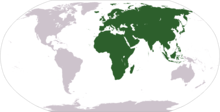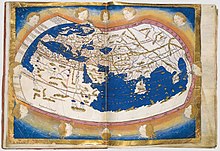
Back Ou Wêreld Afrikaans العالم القديم Arabic Vieyu Mundu AST Köhnə dünya Azerbaijani Стары Свет Byelorussian Стары Сьвет BE-X-OLD Стар свят Bulgarian প্রাচীন বিশ্ব Bengali/Bangla Bed Kozh Breton Stari svijet BS
This article needs additional citations for verification. (March 2013) |



The term "Old World" (Latin: Mundus Vetus) is an archaic 16th century term for Afro-Eurasia that originated in Europe c. 1493, after Europeans had become aware of the existence of the Americas.[1][2] The term is one of several terms utilized to categorize and classify peoples and nations many view as having origins in colonialism and, by extension, racism.[3] The term expresses Eurocentrism as it was used to contrast the continents of Africa, Europe, and Asia in the Eastern Hemisphere, previously thought of by Europeans as comprising the entire world, with the "New World", a term for the newly encountered lands of the Western Hemisphere, particularly the Americas.[4] While located closer to Afro-Eurasia within the Eastern Hemisphere, Australia is considered neither an Old World nor a New World land, since it was only discovered by Europeans after the distinction had been made; both Australia and Antarctica were associated instead with the Terra Australis that had been posited as a hypothetical southern continent.
- ^ "How we classify countries and people—and why it matters". BMJ Glob Health. Retrieved 6 April 2024.
{{cite web}}: CS1 maint: url-status (link) - ^ "Old World". Merriam-Webster Dictionary. Archived from the original on 2 April 2019. Retrieved 3 December 2014.
- ^ "Dear scientists: stop calling America the 'New World'". Nature. Retrieved 6 April 2024.
{{cite web}}: CS1 maint: url-status (link) - ^ "New world". Merriam-Webster Dictionary. Archived from the original on 2 April 2019. Retrieved 2 April 2013.